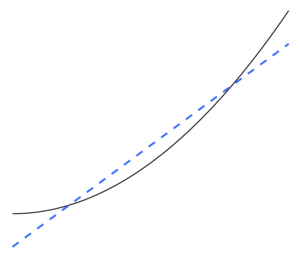overfitting
pretirano prileganje, prekomerno prileganje
This article needs additional citations for verification. (August 2017) (Learn how and when to remove this template message) |

In statistics, overfitting is "the production of an analysis that corresponds too closely or exactly to a particular set of data, and may therefore fail to fit additional data or predict future observations reliably". An overfitted model is a statistical model that contains more parameters than can be justified by the data. The essence of overfitting is to have unknowingly extracted some of the residual variation (i.e. the noise) as if that variation represented underlying model structure.
Underfitting occurs when a statistical model cannot adequately capture the underlying structure of the data. An under-fitted model is a model where some parameters or terms that would appear in a correctly specified model are missing. Under-fitting would occur, for example, when fitting a linear model to non-linear data. Such a model will tend to have poor predictive performance.
Over-fitting and under-fitting can occur in machine learning, in particular. In machine learning, the phenomena are sometimes called "over training" and "under-training".
The possibility of over-fitting exists because the criterion used for selecting the model is not the same as the criterion used to judge the suitability of a model. For example, a model might be selected by maximizing its performance on some set of training data, and yet its suitability might be determined by its ability to perform well on unseen data; then over-fitting occurs when a model begins to "memorize" training data rather than "learning" to generalize from a trend.
As an extreme example, if the number of parameters is the same as or greater than the number of observations, then a model can perfectly predict the training data simply by memorizing the data in its entirety. (For an illustration, see Figure 2.) Such a model, though, will typically fail severely when making predictions.
The potential for overfitting depends not only on the number of parameters and data but also the conformability of the model structure with the data shape, and the magnitude of model error compared to the expected level of noise or error in the data.[citation needed] Even when the fitted model does not have an excessive number of parameters, it is to be expected that the fitted relationship will appear to perform less well on a new data set than on the data set used for fitting (a phenomenon sometimes known as shrinkage). In particular, the value of the coefficient of determination will shrink relative to the original data.
To lessen the chance of, or amount of, overfitting, several techniques are available (e.g. model comparison, cross-validation, regularization, early stopping, pruning, Bayesian priors, or dropout). The basis of some techniques is either (1) to explicitly penalize overly complex models or (2) to test the model's ability to generalize by evaluating its performance on a set of data not used for training, which is assumed to approximate the typical unseen data that a model will encounter.




